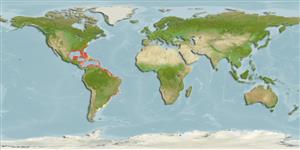Actinopterygii (ray-finned fishes) >
Perciformes (Perch-likes) >
Serranidae (Sea basses: groupers and fairy basslets) > Serraninae
Etymology: Diplectrum: Greek, di = two + Greek, plektron = sting, spur (Ref. 45335).
Environment / Climate / Range
Ecology
Marine; brackish; demersal; depth range ? - 55 m (Ref. 26912). Tropical; 20°C - 25°C (Ref. 36323), preferred ?
Western Atlantic: southern Caribbean to Brazil. Record from the Virgin Islands needs verification.
Size / Weight / Age
Maturity: Lm ? range ? - ? cm
Max length : 26.0 cm TL male/unsexed; (Ref. 5217); common length : 20.0 cm TL male/unsexed; (Ref. 5217)
Dorsal
spines
(total): 10;
Dorsal
soft rays
(total): 12-14;
Anal
spines: 3;
Anal
soft rays: 7. Body dusky green with 2 longitudinal dark stripes; cheeks yellowish olive with diagonal blue stripes; fins dusky; anal and caudal fins with a tinge of yellow (Ref. 13608). Preopercle with a single prominent group of spines at the angle; 3 flat spines on posterior part of opercle. Soft portions of dorsal and anal fin bases without scales. Pectoral fin longer than pelvic fin. Caudal fin with no elongated ray (Ref. 36323).
Occurs commonly in coastal waters and also enter estuarine regions (Ref. 36323). Found over soft bottoms. Flesh is of good quality and is eaten fresh.
Life cycle and mating behavior
Maturity | Reproduction | Spawning | Eggs | Fecundity | Larvae
Cervigón, F., R. Cipriani, W. Fischer, L. Garibaldi, M. Hendrickx, A.J. Lemus, R. Márquez, J.M. Poutiers, G. Robaina and B. Rodriguez, 1992. Fichas FAO de identificación de especies para los fines de la pesca. Guía de campo de las especies comerciales marinas y de aquas salobres de la costa septentrional de Sur América. FAO, Rome. 513 p. Preparado con el financiamento de la Comisión de Comunidades Europeas y de NORAD. (Ref. 5217)
IUCN Red List Status (Ref. 115185)
CITES (Ref. 94142)
Not Evaluated
Threat to humans
Harmless
Human uses
Fisheries: minor commercial
More information
ReferencesAquacultureAquaculture profileStrainsGeneticsAllele frequenciesHeritabilityDiseasesProcessingMass conversion
Tools
Special reports
Download XML
Internet sources
